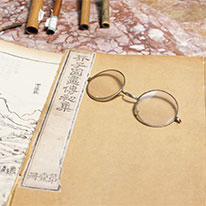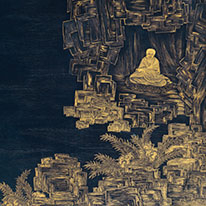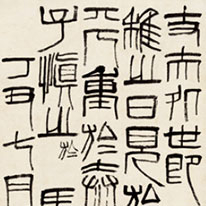Past Exhibitions
- Feature Exhibition
Qi Baishi: Master of Modern Chinese Painting
"Landscapes," "Gods and Human Figures," "Calligraphy and Seals," "Study" - January 30, 2019 - March 17, 2019
The Chinese painter Qi Baishi (1864–1957), known for his clean ink lines and simple colors, has risen in recent years to extraordinary international prominence and popularity. This exhibition, which celebrates the 40th anniversary of the Treaty of Peace and Friendship between Japan and China, features masterworks from the Beijing Art Academy, to which the artist's family donated many works, together with significant paintings from the Kyoto National Museum's Suma Collection, which have long been preserved in Japan. This is a rare opportunity for visitors to view some of Qi Baishi's greatest works from leading collections in both countries.
The exhibition has two installations:
Part I: January 30-February 24, 2019
Part II: February 26-March 17, 2019
Gods and Human Figures: The Culmination of Qi Baishi's Originality
Although early in his career Qi Baishi produced realistic portraits and detailed paintings of beautiful women, he later grew to favor simpler forms based on robust lines. Baishi’s human figures delight the eye with their exaggerated, almost comical depictions in deft brushstrokes.
Calligraphy and Seals: Rich Aesthetics and Sensitivity
Qi Baishi developed an interest in seal carving at a young age as well as a love of the scripts upon which it was based. After studying the carvings of the Zhe School and Zhao Zhiqian (1829–1884), he later explored seal scripts dating from the Qin dynasty (221–207 B.C.) to the Three Kingdoms period (A.D. 220–280), establishing his own unique styles and chiseling techniques. Baishi's seal carving is characterized by rigid, well-modulated thick and thin lines, simple shapes, and compositions that emphasize the contrast between the red of the ink and the white of the paper. His bold, dynamic chiseling style also reflects his experience as a woodworker and joiner.
Study: Origins of Creation
In Qi Baishi's younger and poorer days, he is said to have borrowed picture books from acquaintances and copied them by laying thin sheets of paper over each page and tracing the pictures with fine outlines. Later, he continued to accumulate sketches by carefully copying old paintings and by sketching real-life scenery on his travels. These sketches could be considered the origins of Baishi's creative work.
Although Baishi did not come from an academic family, he learned how to compose poetry to serve as inscriptions on his paintings. Writing poems eventually became one of his great pleasures. Baishi's living, breathing artistry can be found in the manuscripts of his poetry anthologies and in the journal in which he recorded his daily inspirations.
-
-

-
Pair of Glasses
Beijing Fine Art Academy
[on view: January 30-March 17, 2019]
*Image is for illustration purposes. Actual display may differ from the image.
-
Other Galleries
Feature Exhibition
Qi Baishi: Master of Modern Chinese Painting
【Gallery 2F-1】"Flowers and Trees"
【Gallery 2F-2】"Birds and Animals," "Insects"
【Gallery 2F-3】"Insects," "Fish and Shrimp," "Landscapes"
Related Exhibition
【Gallery 2F-5】Masterworks of Qi Baishi from the Suma Collection













